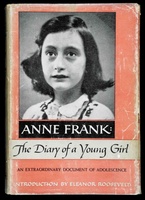Frank: ‘Anne Frank: The Diary of a Young Girl’
Writing is an act of faith—a measure of trust in words’ ability to communicate what the author wishes to communicate. In Anne Frank’s diary, written in hiding between the ages of thirteen and fifteen, one finds an astonishing trust tested by the horrors of her own time. Her entry on July 15, 1944, is only one of many examples:
“It’s a wonder I haven’t abandoned all my ideals, they seem so absurd and impractical. Yet I cling to them because I still believe, in spite of everything, that people are truly good at heart. It’s utterly impossible for me to build my life on a foundation of chaos, suffering and death. I see the world being slowly transformed into a wilderness, I hear the approaching thunder that, one day, will destroy us too, I feel the suffering of millions.
And yet, when I look up at the sky, I somehow feel that everything will change for the better, that this cruelty too shall end, that peace and tranquility will return once more.”
—Sandra Yocum, PhD, Associate Professor, Religious Studies
Diary entry July 15 from Anne Frank's "Het Achterhuis (Anne Frank: The Diary of a Young Girl)" Sheila Hassell Hughes, Professor. University of Dayton. Department of English

